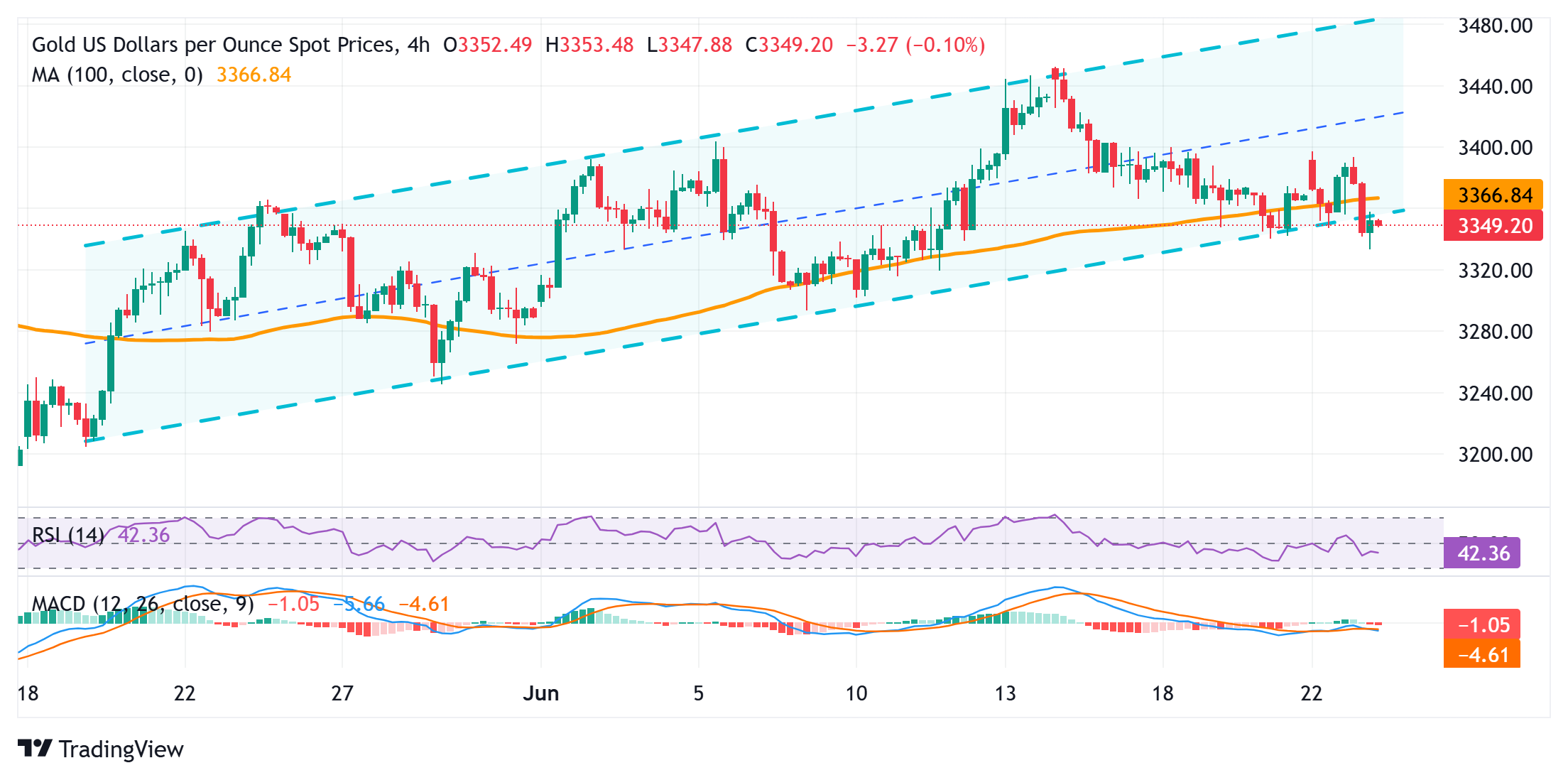- Gold price extends the previous day’s slide amid the Israel-Iran ceasefire announcement.
- July Fed rate cut bets weigh heavily on the USD, supporting the non-yielding commodity.
- The XAU/USD bears seem reluctant to commit ahead of speeches from FOMC members.
Gold price (XAU/USD) maintains its heavily offered tone through the first half of the European session and currently trades just above a nearly two-week low touched earlier this Tuesday. News of the Iran-Israel ceasefire boosts investors’ confidence and triggers a fresh wave of global risk-on trade, which, in turn, is seen as a key factor driving flows away from the safe-haven precious metal.
Meanwhile, the intraday downfall seems rather unaffected by some follow-through US Dollar (USD) selling, which tends to benefit the Gold price. The mixed US PMI data and dovish remarks from Fed officials fueled speculations about the possibility of a rate cut in July. This, in turn, drags the USD to over a one-week low and could support the commodity ahead of Fed Chair Jerome Powell’s testimony.
Daily Digest Market Movers: Gold price selling bias remains unabated despite a broadly weaker USD
- US President Donald Trump announced that Israel and Iran have agreed to a complete and total ceasefire, providing a goodish lift to the global risk sentiment. However, reports suggest that Israel has launched some attacks against Iran.
- Moreover, Iran’s Foreign Minister, Abbas Araqchi, said that if Israel stopped its illegal aggression against the Iranian people no later than 00.30 GMT on Tuesday, Iran had no intention of continuing its response afterward, per Reuters.
- This, along with persistent trade-related uncertainties, keeps a lid on the market optimism. Apart from this, some follow-through US Dollar selling for the second straight day could assist the Gold price to stall the fall to a nearly two-week low.
- Meanwhile, data released on Monday showed that S&P Global’s flash Manufacturing PMI held steady at 52 in June, while the gauge for the service sector cooled slightly to 53.1 from 53.7 and the composite index slipped to 52.8 from 53.0 in May.
- Adding to this, Federal Reserve Governor Michelle Bowman said that the time to cut rates may be fast approaching as she has grown more worried about risks to the job market and less concerned that tariffs will cause an inflation problem.
- This backs Fed Governor Christopher Waller’s view that the US central bank should consider cutting interest rates at its next policy meeting on July 29-30, which keeps the USD depressed and further supports the non-yielding yellow metal.
- Traders now look to the US economic docket – featuring the release of the Conference Board’s Consumer Confidence Index and the Richmond Manufacturing Index. This, along with speeches by influential FOMC members, will drive the USD.
- The focus, however, will remain glued to Fed Chair Jerome Powell’s testimony before the House Financial Services Committee, which could offer cues about the future rate-cut path and determine the near-term trajectory for the XAU/USD pair.
Gold price bears might now wait for a break below $3,300 before positioning for further losses

From a technical perspective, the commodity now seems to have found acceptance below the 100-period Simple Moving Average (SMA) on the 4-hour chart and is looking to extend the fall below a short-term ascending channel support. Moreover, oscillators on the said chart have been gaining negative traction and back the case for a further intraday depreciating move. Some follow-through selling below the $3,323-3,322 intermediate support will reaffirm the outlook and drag the Gold price to sub-$3,300 levels.
On the flip side, any meaningful recovery beyond the $3,368-3,370 immediate hurdle is more likely to attract fresh sellers and remain capped near the $3,400 round figure. The latter should act as a key pivotal point, which if cleared decisively could lift the Gold price to the $3,434-3,435 area en route to the $3,451-3,452 zone, or a nearly two-month top touched last Monday. The subsequent move up could extend further towards challenging the all-time peak, around the $3,500 psychological mark.
US Dollar PRICE Today
The table below shows the percentage change of US Dollar (USD) against listed major currencies today. US Dollar was the strongest against the Swiss Franc.
| USD | EUR | GBP | JPY | CAD | AUD | NZD | CHF | |
|---|---|---|---|---|---|---|---|---|
| USD | -0.19% | -0.53% | -0.78% | -0.12% | -0.70% | -0.75% | -0.03% | |
| EUR | 0.19% | -0.38% | -0.59% | 0.07% | -0.51% | -0.99% | 0.18% | |
| GBP | 0.53% | 0.38% | -0.24% | 0.45% | -0.13% | -0.62% | 0.41% | |
| JPY | 0.78% | 0.59% | 0.24% | 0.68% | 0.05% | -0.00% | 0.64% | |
| CAD | 0.12% | -0.07% | -0.45% | -0.68% | -0.59% | -1.06% | -0.04% | |
| AUD | 0.70% | 0.51% | 0.13% | -0.05% | 0.59% | -0.48% | 0.54% | |
| NZD | 0.75% | 0.99% | 0.62% | 0.00% | 1.06% | 0.48% | 1.03% | |
| CHF | 0.03% | -0.18% | -0.41% | -0.64% | 0.04% | -0.54% | -1.03% |
The heat map shows percentage changes of major currencies against each other. The base currency is picked from the left column, while the quote currency is picked from the top row. For example, if you pick the US Dollar from the left column and move along the horizontal line to the Japanese Yen, the percentage change displayed in the box will represent USD (base)/JPY (quote).